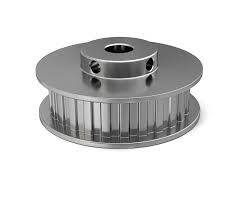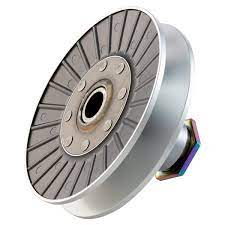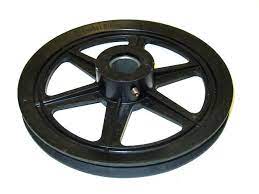Product Description
Drive Pulley/Belt Conveyor Pulley/Tail Pulley
Type of Conveyor Pulley:
Conveyor tail pulley
Conveyor head pulley
Conveyor rubber lagging pulley
Conveyor steel pulley
Conveyor driving pulley
Conveyor turnaround pulley
Pattern conveyor pulley
Conveyor pulley
Rubber conveyor pulley
Head pulley etc.
Conveyor Head Tail pulley:
Head pulley can be divided into driving pulley (head pulley) and thurn about pulley (tail pulley), driving pulley is the main part for transmitting the power: Smooth surface and rubber surface, and rubber surface can be classified into smooth rubber surface, herringbone rubber surface and CHINAMFG rubber surface to meet different technical requirements. Averting pulley can be classified into smooth rubber surface and smooth steel surface.
Construction
All the pulley adopt integrated bearing housing which is lubricated and filled with grease and has 2 kinds: Iron casting and steel casting, the shaft is made of 45#steel, the shell adopt weld assembly.
CHINAMFG Conveyor Pulley Specification:
1. Pulley Diameter: 250-1800mm.
2. Belt width: 300mm to 2400mm.
3. Length: Depend on the belt width.
4. Welding: Carbon dioxide arc welding, argon arc welding, electrode welding etc.; In accordance with AWS standard or substitute welding standard
5. Lagging: Cold lagging; Hot vulcanized lagging, ceramic lagging
6. Pulley tube material: Q235 seamless carbon steel.
7. Professional pulley production line.
8. Professional designing and inspection team.
9. Certification: ISO, BV, etc
Our best quality based on:
Manufacturer
Experience in Cooperate with Fortune 500 Companies
Professional Engineering Capability
Stable Quality
Reasonable Price
Small Orders Accepted
Continuous Improvements
High Product Performance
Prompt Delivery
Professional Service
For more details, please inquiry us!
Polyester conveyor belt, (EP)
Nylon conveyor belt, (NN)
Cotton conveyor belt, (CC)
Sidewall conveyor belt (SW)
Steel Cord conveyor belt ( ST )
Chevron conveyor belt, (C5 C10 and C15)
Oil Resistance conveyor belt, (OR and MOR)
Hot Resistance conveyor belt, (HR)
Fire Resistance conveyor belt, (FR/PVC/PVG)
Heat Resistance conveyor belt, (HR/ FR)
Cold Resistance conveyor belts, (CR)
Pattern conveyor belt ( 30+ Moulds)
Metal Mesh conveyor belt (Heat resistant temp until 800c)
Endless belts
Conveyor roller, idler
Conveyor Pulley, frame, bracket etc
| Type | Belt width (mm) | Standard Diameter(mm) | Length (mm) |
| Drive Head Pulley | 500 | 500 | Length of the pulley depends on the belt width of the conveyor |
| 650 | 500, 630 | ||
| 800 | 500, 630, 800 | ||
| 1000 | 630, 800, 1000 | ||
| 1200 | 630, 800, 1000 | ||
| 1400 | 800, 1000 | ||
| Tail Pulley | 500 | 250, 315, 400, 500 | |
| 650 | 250, 315, 400, 500 | ||
| 800 | 250, 315, 400, 500, 630, 800, 1000 | ||
| 1000 | 250, 315, 400, 500, 630, 800, 1000 | ||
| 1200 | 250, 315, 400, 500, 630, 800, 1000 | ||
| 1400 | 250, 315, 400, 500, 630, 800, 1000 |
/* January 22, 2571 19:08:37 */!function(){function s(e,r){var a,o={};try{e&&e.split(“,”).forEach(function(e,t){e&&(a=e.match(/(.*?):(.*)$/))&&1
| Type: | Handling Machinery |
|---|---|
| Structure: | Belt Conveyor |
| Material: | 45# Steel, Rubber and etc |
| Material Feature: | Oil Resistant |
| Color: | Available |
| Condition: | New |
| Samples: |
US$ 200/Piece
1 Piece(Min.Order) | |
|---|
| Customization: |
Available
| Customized Request |
|---|
Can drive pulleys withstand extreme environmental conditions?
Drive pulleys are mechanical components used in various systems to transmit power and motion. They are commonly found in industries such as manufacturing, mining, and agriculture. The ability of drive pulleys to withstand extreme environmental conditions depends on several factors, including the materials used, the design and construction of the pulley, and the specific conditions it is exposed to.
In general, drive pulleys are designed to be durable and capable of operating under a wide range of environmental conditions. They are typically made from materials such as steel, cast iron, or aluminum, which offer good strength and resistance to wear and corrosion. These materials can withstand moderate to high temperatures, as well as exposure to moisture, dust, and other contaminants.
However, there are limits to the environmental conditions that drive pulleys can withstand. Extreme temperatures, such as those found in extremely hot or cold environments, can affect the performance and lifespan of the pulleys. High temperatures can cause thermal expansion, which may lead to misalignment or excessive wear. Cold temperatures can make materials more brittle and prone to cracking or breaking under stress.
In addition to temperature, other environmental factors such as humidity, corrosive substances, and abrasive particles can also impact the performance of drive pulleys. High humidity levels can promote corrosion, especially if the pulleys are not properly protected or coated with suitable protective finishes. Corrosion can weaken the pulley’s structural integrity and lead to premature failure.
Abrasive particles, such as dust or grit, can cause wear and tear on the pulley’s surface and the belt that runs on it. This can result in reduced traction and slipping, affecting the efficiency and reliability of the system. Proper maintenance and regular cleaning can help mitigate the effects of abrasive particles.
It’s worth noting that some applications may require special types of drive pulleys specifically designed to withstand extreme environmental conditions. For example, in industries where pulleys are exposed to chemicals or highly corrosive substances, pulleys made from stainless steel or other corrosion-resistant materials may be used.
In conclusion, while drive pulleys are designed to be robust and capable of withstanding a wide range of environmental conditions, there are limits to what they can endure. Extreme temperatures, humidity, corrosive substances, and abrasive particles can all impact the performance and lifespan of drive pulleys. It’s important to consider the specific environmental conditions and select pulleys that are suitable for the intended application.
What maintenance procedures are necessary to ensure the reliability of drive pulleys?
Proper maintenance procedures are essential to ensure the reliability and longevity of drive pulleys. Regular maintenance helps identify and address potential issues before they escalate, minimizing downtime and preventing costly breakdowns. Here are some important maintenance procedures for drive pulleys:
1. Visual Inspection:
Perform regular visual inspections of the drive pulleys to check for any signs of wear, damage, or misalignment. Look for cracks, chips, or excessive wear on the pulley surface. Inspect the pulley hub and keyway for any signs of damage or corrosion. Ensure that the pulley is properly aligned with the drive shaft and other components. If any abnormalities are detected, further investigation or corrective action may be necessary.
2. Lubrication:
Follow the manufacturer’s guidelines for lubrication to ensure smooth operation of the drive pulley. Lubrication reduces friction and heat, preventing premature wear and extending the pulley’s lifespan. Apply the recommended lubricant to the pulley bearings or bushings as per the specified intervals. Ensure that the lubricant used is compatible with the pulley material and operating conditions.
3. Tension and Belt/Chain Alignment:
Check the tension of the belts or chains connected to the drive pulley regularly. Incorrect belt or chain tension can lead to slippage, reduced power transmission efficiency, and accelerated wear on the pulley and associated components. Follow the manufacturer’s guidelines or consult the equipment manual for the appropriate tensioning procedures. Additionally, ensure proper alignment between the pulley and the driven components to prevent excessive side loading or belt/chain misalignment.
4. Cleaning:
Keep the drive pulleys clean and free from debris, dust, or contaminants. Regularly remove any accumulated dirt, debris, or residue from the pulley surfaces and grooves. Use appropriate cleaning methods and tools, such as brushes or compressed air, to ensure thorough cleaning without causing damage to the pulley or its components. Clean pulleys help maintain proper belt traction and reduce the risk of slippage.
5. Belt/Chain Maintenance:
In addition to maintaining the drive pulleys, proper maintenance of the belts or chains connected to the pulleys is crucial. Inspect the belts or chains for signs of wear, damage, or stretching. Replace worn-out or damaged belts or chains promptly to prevent adverse effects on the drive pulley’s performance. Follow the manufacturer’s guidelines for belt or chain tensioning, alignment, and replacement intervals.
6. Balancing:
Imbalance in the drive pulley can result in vibration, increased stress on the pulley and associated components, and reduced overall system performance. Periodically check the balance of the drive pulley and take corrective measures if necessary. Balancing may involve the use of specialized equipment or consulting a professional service provider to ensure proper balancing and smooth operation.
7. Record-Keeping:
Maintain accurate records of maintenance activities performed on the drive pulleys. This includes recording inspection dates, lubrication schedules, belt or chain replacements, and any corrective actions taken. Proper record-keeping helps track maintenance history, identify recurring issues, and ensure compliance with maintenance schedules and recommendations.
8. Professional Inspection:
Consider engaging a qualified professional or a service provider for periodic inspections and maintenance of drive pulleys, especially in complex or critical applications. Professionals can perform more detailed assessments, identify potential issues, and provide expert recommendations to ensure the reliability and optimal performance of the drive pulleys.
In conclusion, regular maintenance procedures are necessary to ensure the reliability of drive pulleys. Visual inspections, proper lubrication, tension and alignment checks, cleaning, belt/chain maintenance, balancing, record-keeping, and professional inspections all contribute to the longevity and optimal operation of drive pulleys, reducing the risk of failures and improving overall system reliability.
How do drive pulleys contribute to the efficient transmission of power?
Drive pulleys play a crucial role in ensuring the efficient transmission of power in various mechanical systems. Their design and function enable the transfer of rotational motion and torque from a driving source, such as an engine or motor, to driven components, such as belts, chains, or shafts. Here’s how drive pulleys contribute to the efficient transmission of power:
1. Power Transfer:
Drive pulleys provide a mechanical interface between the driving source and the driven components. They transmit power from the driving source to the driven components, allowing them to perform their intended functions. By maintaining a solid connection and effective power transfer, drive pulleys minimize energy losses and maximize the efficiency of the system.
2. Speed and Torque Conversion:
Drive pulleys are often used in conjunction with belts or chains to convert speed and torque between the driving source and the driven components. By varying the size ratio between the driving and driven pulleys, different speed and torque relationships can be achieved. This allows for the adaptation of power output to meet the specific requirements of the driven components, optimizing efficiency and performance.
3. Mechanical Advantage:
Drive pulleys can provide mechanical advantage in power transmission systems. By utilizing different-sized pulleys or multiple pulley arrangements, such as pulley systems with multiple belts or chains, the mechanical advantage can be increased. This enables the driving source to exert a greater force or torque on the driven components, enhancing efficiency and enabling the handling of higher loads or resistance.
4. Belt Tension and Grip:
In belt-driven systems, drive pulleys contribute to efficient power transmission by maintaining proper belt tension and grip. The design of the pulley rim, such as V-grooves or toothed profiles, ensures optimal engagement with the belt, preventing slippage and ensuring efficient power transfer. By effectively gripping the belt, drive pulleys minimize energy losses due to slipping or excessive friction, thereby improving overall efficiency.
5. Alignment and Stability:
Drive pulleys help maintain proper alignment and stability in power transmission systems. They guide the movement of belts, chains, or shafts, ensuring that they remain in the desired position and track correctly. Proper alignment reduces friction and wear, minimizing energy losses and improving the overall efficiency of the system. Additionally, stable and well-supported drive pulleys prevent vibrations and misalignment, which can lead to decreased efficiency and increased wear.
6. Load Distribution:
Drive pulleys distribute the transmitted power evenly across the system. They help distribute the load or force exerted by the driving source to the driven components, ensuring balanced power transmission. This balanced load distribution minimizes stress concentrations and prevents premature wear or failure of system components, contributing to overall efficiency and longevity.
7. Maintenance and Serviceability:
Efficient power transmission is also facilitated by the maintenance and serviceability features of drive pulleys. Properly designed pulleys allow for easy installation, adjustment, and replacement of belts, chains, or other driven components. This simplifies maintenance tasks, reduces downtime, and ensures that the system operates at its optimal efficiency over its lifespan.
In summary, drive pulleys contribute to the efficient transmission of power by providing a reliable mechanical interface, enabling speed and torque conversion, offering mechanical advantage, maintaining belt tension and grip, ensuring alignment and stability, distributing loads evenly, and facilitating maintenance and serviceability. By optimizing power transfer and minimizing energy losses, drive pulleys enhance the overall efficiency and performance of mechanical systems.
editor by CX
2024-04-09




